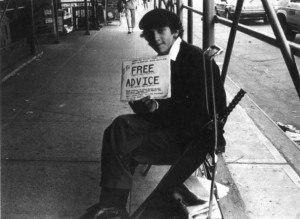07.30.14On Teachers and the Advice They Get
 Teachers are drowning in advice. Most of the time teachers are tasked with executing ideas and directives that come from people who don’t actually teach every day. Perhaps as a result, many of those ideas and directives are disconnected from the endemic problems that shape their daily work. This tends to exacerbate the wide range of potential guidance teachers receive. Anything is fair game–what’s germane to the daily struggle and what’s not. It’s worth asking then what advice should look like. After all, even if teachers consistently got advice about endemic problems, it could be bad advice. I think of guidance as coming in three varieties: ideology-driven, research-driven, and data-driven.
Teachers are drowning in advice. Most of the time teachers are tasked with executing ideas and directives that come from people who don’t actually teach every day. Perhaps as a result, many of those ideas and directives are disconnected from the endemic problems that shape their daily work. This tends to exacerbate the wide range of potential guidance teachers receive. Anything is fair game–what’s germane to the daily struggle and what’s not. It’s worth asking then what advice should look like. After all, even if teachers consistently got advice about endemic problems, it could be bad advice. I think of guidance as coming in three varieties: ideology-driven, research-driven, and data-driven.
Ideology-driven guidance represents the most common form of advice teachers receive. For time immemorial, people have thought of things that could or should happen in classrooms and proceeded to tell teachers to do them. This kind of guidance tends to say, “This is what a classroom should be like,” which is problematic even if you agree with the idea in question. A teacher might be told that a classroom should be democratic, for example, and perhaps given some parameters for what a democratized classroom should look like, but the assessment of such a classroom is not whether student achievement rose but whether the teacher did what the democratizing guidance described. Assessment of the effectiveness of an ideology is usually self-reinforcing. Teachers in such cases are asked not to use and adapt ideas as they see fit to get to a few important outcomes—student achievement in a given subject, say—but rather to assess results by checking off a growing stack of “musts”:  teachers must teach English, math, science, history, the arts, banking and financial literacy, environmental stewardship, entrepreneurship, and personal hygiene, in a technology-rich environment that builds self-esteem, seats students in pods, provides multiple solutions to every problem, avoids “teacher talk,” and never exposes a student to a page of text that has more than five vocabulary words he or she doesn’t know. Please don’t forget the anti-drug unit. In other words, ideology-based guidance contributes to the development of schools where teachers are always trying to do lots of things that people are telling them to do, instead of using their insight, problem-solving abilities, and a wide array of tools to achieve specific goals. The result, often, is an administrator with a checklist.
teachers must teach English, math, science, history, the arts, banking and financial literacy, environmental stewardship, entrepreneurship, and personal hygiene, in a technology-rich environment that builds self-esteem, seats students in pods, provides multiple solutions to every problem, avoids “teacher talk,” and never exposes a student to a page of text that has more than five vocabulary words he or she doesn’t know. Please don’t forget the anti-drug unit. In other words, ideology-based guidance contributes to the development of schools where teachers are always trying to do lots of things that people are telling them to do, instead of using their insight, problem-solving abilities, and a wide array of tools to achieve specific goals. The result, often, is an administrator with a checklist.
Gradually, the guidance that teachers receive has begun to be more research-driven. Research matters, so that’s a step in the right direction, but there are still problems. Research needs to be distilled and digested for application. If the research supports a particular action, does that mean you should always perform that action? To the exclusion of everything else? Or should you combine it with other things? If so, how often, in what settings, and with what other actions? And how do you meld them? Even if you nailed all those questions, the research might not prove effective until you’d figured out the details of implementing it in, say, forty-six minutes on Tuesday morning with  thirty-one fourth graders of widely varying skill levels. Or, it might not be of any value at all–there’s a lot of research out there of varying quality, and even the useful parts are interpreted with a mix of good sense, cautious fidelity, outright distortion, and blind orthodoxy. This can result in “research” justifying poor teaching as easily as good. Research, in other words, works best when it is a tool, not a program—adapted and applied by professionals to achieve a specific goal and then assessed to determine whether and how it helps them meet that goal.
thirty-one fourth graders of widely varying skill levels. Or, it might not be of any value at all–there’s a lot of research out there of varying quality, and even the useful parts are interpreted with a mix of good sense, cautious fidelity, outright distortion, and blind orthodoxy. This can result in “research” justifying poor teaching as easily as good. Research, in other words, works best when it is a tool, not a program—adapted and applied by professionals to achieve a specific goal and then assessed to determine whether and how it helps them meet that goal.
This brings up the third type of advice for teachers: data-driven guidance. Data-driven guidance is based not on what should happen but on what did happen when success was achieved. How were all the ideas and research knitted together and executed so as to survive their encounter with twenty-eight moderately skeptical seventh graders? What else had to happen to achieve that singular triumph? What were the themes and variations teachers employed across multiple successful lessons, considering their own personality, setting, and context? It’s not simple, this data-driven guidance, and it has pitfalls of its own, but as you have probably guessed, this book is an effort to bring that kind of guidance to teachers, based on the work of those peers who successfully solve endemic problems.
To paraphrase a wise colleague, the only thing I know for sure about my own efforts at data driven guidance is that I got some of it wrong. Surely, when one of the teachers I was watching did the thing that drove her results, I was looking in the other direction, misunderstanding what she’d done, confusing cause for effect, or seeing what I wanted to see at least some of the time. But one of the great things about data-driven guidance is that anyone can seek it out. Even if you disagree with my conclusions, whether you are a teacher or a leader in charge of a school, a school district, a state, or a nation, you can use a data-driven approach to take your best shot at measuring the outcome you think most valuable, finding its best practitioners, and inferring guidance from their work.
One major benefit of a data-driven approach is that it generates its knowledge from teachers: it’s the process of showing teachers a picture of themselves at their very best. As a result, it considers teachers not just as recipients and implementers of the field’s knowledge but as creators of it—problem solvers, entrepreneurs, generators of professional insight. It makes teachers intellectuals. That, I think, really matters. It not only honors teachers and teaching but ideally also changes the perception of the field and the stature of the work.
We often talk about “the” achievement gap, but really there are many: the gap between rich and poor, true, but also the gap between what students think and what they can write; the gap between schools in our nation and the best school systems in the world; and the gap between what our schools offer and what they could be. One of the key messages of this book is that solutions to teaching’s achievement gaps exist. There is no gap that has not been closed already by some teacher somewhere. We are not suffering from a lack of solutions so much as a failure to glean the insights from those teachers and put them to work.

This idea is what vastly improved my own personal practice as an educator when I read TLAC the first time during the summer of 2010 and I have carried it with me ever since. Currently, I am revising a principal preparation program’s scope and sequence based upon the premise that we should exclusively train our aspiring principals on proven data driven best practices that teachers and leaders have used to close the achievement gap in their own classrooms and schools. Thanks for articulating this idea so clearly here.
Thanks, Paul. A great (and much needed) premise for a principal preparation program! Wish you the best with it.